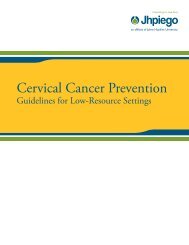Manual for Male Circumcision under Local Anaesthesia
Manual for Male Circumcision under Local Anaesthesia
Manual for Male Circumcision under Local Anaesthesia
Create successful ePaper yourself
Turn your PDF publications into a flip-book with our unique Google optimized e-Paper software.
<strong>Male</strong> circumcision <strong>under</strong> local anaesthesia<br />
Version 3.1 (Dec09)<br />
What are “good data”<br />
A monitoring system will provide useful in<strong>for</strong>mation only if the data<br />
recorded are “good”. Clinic managers should ensure that staff are<br />
aware of the following:<br />
• Understanding the data. Staff responsible <strong>for</strong> keeping records<br />
should know exactly what in<strong>for</strong>mation is needed, <strong>for</strong> example,<br />
adverse events associated with male circumcision.<br />
• Recording the data every time. Every time a staff member<br />
per<strong>for</strong>ms a procedure, sees a client, prescribes medication,<br />
receives a test result, or makes a referral, it should be recorded on<br />
the appropriate <strong>for</strong>m.<br />
• Recording all the data. All the in<strong>for</strong>mation requested on the<br />
monitoring <strong>for</strong>ms should be completed. This might require noting<br />
when a particular treatment was not provided.<br />
• Recording the data in the same way every time. The same<br />
definitions, rules, and tests should always be used <strong>for</strong> reporting the<br />
same piece of in<strong>for</strong>mation. In the long term, this may not be<br />
possible, as tests and definitions change, treatment evolves and<br />
new technologies are developed. When it is not possible to record<br />
data in the same way, a note should be made describing the<br />
change.<br />
It is not the role of clinicians (surgeons or medical, clinical and nursing<br />
officers) to develop a functional monitoring system <strong>for</strong> the facility. That<br />
is the role of the health planner or clinic manager. However, the<br />
clinicians need to know who is responsible <strong>for</strong> the monitoring system,<br />
to record data accurately and reliably, and to know how and when to<br />
report in<strong>for</strong>mation related to the service or to patients.<br />
Clinicians can also help those responsible <strong>for</strong> the system by providing<br />
feedback about how the system is working, how in<strong>for</strong>mation is shared<br />
with other clinicians, and how easy the various <strong>for</strong>ms are <strong>for</strong> clinicians<br />
to complete accurately and reliably. In this way, the monitoring system<br />
to be as accurate and reliable as possible.<br />
Using monitoring in<strong>for</strong>mation <strong>for</strong> intervention-related decisionmaking<br />
In the context of record-keeping and monitoring, in<strong>for</strong>mation is good<br />
only if it can be used. Data that cannot be used should not be<br />
collected.<br />
QUALITY ASSURANCE<br />
Quality assurance is the assessment or measurement of the quality of<br />
care and services and the implementation of any necessary changes<br />
to either maintain or improve the quality of care rendered. Quality<br />
assurance has also been defined as a systematic process <strong>for</strong> closing<br />
the gap between actual per<strong>for</strong>mance and desirable outcomes.<br />
Record keeping, monitoring, evaluation and supervision Chapter 9-4
















